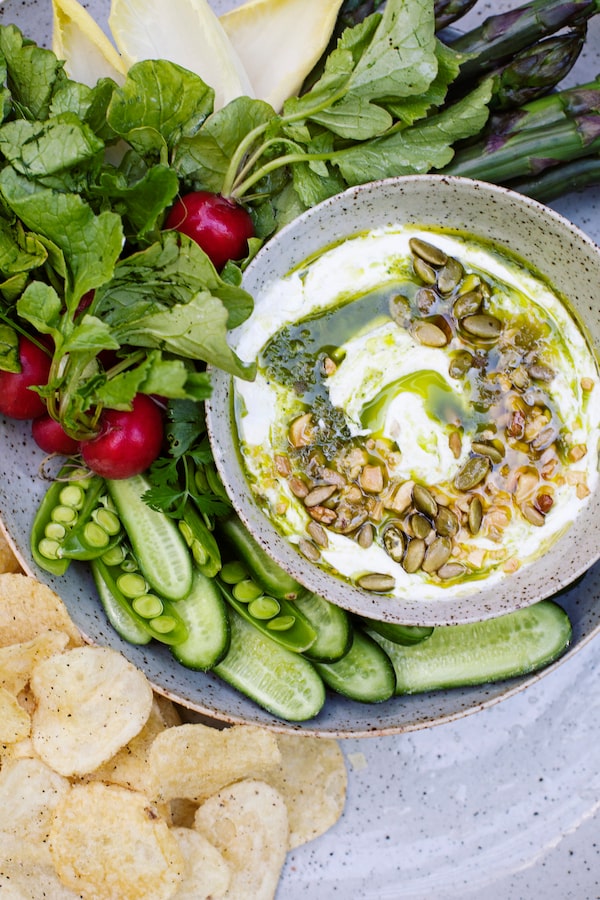
Burnt chile cilantro dip.Tara O'Brady/The Globe and Mail
While I would never pretend it is a replacement for fries shared among a table of friends, a crudité platter serves an adjacent function – nibbly, generous food that pairs well with drinks and conversation. The rendition needn’t be fancy, but it should be solidly good, hitting the right notes of savouriness and vibrancy.
In 2017, Camille Becerra, chef at New York’s De Maria at the time, gave crudité a fashion moment of note, presenting a bowl of jicama, watermelon radish and Asian pears in oblique cuts, intentionally imperfect, so that they stood on end in a spiked, bite-sized mountain range. Draped in an inky dressing and speckled by gomashio (a Japanese sesame seed salt, also known as gomasio) it was a graphic reimagining of the dish, unlike any expectation of a veggie tray.
The crudité on menus of late would be arguably deemed more casual, or at least with an emphasis less on turning the vegetables into art but instead allowing them to be art as they are. Picture an attractively haphazard tumble of all things crunchy for dipping – leggy sticks of rainbow carrots, wafer-thin rounds of candy-striped beets, neon romanesco florets and the like. Green beans. asparagus and broccolini are blanched tender-crisp and plunged into ice, so they come to the table loudly crunchy and spine-tinglingly cold (sometimes, the ice comes to the table as well, with the crudité served upon a bed of icebergs).
Here, I’ve made a dip that is a refreshing summertime favourite. It comes across a bit like a ranch dressing that’s travelled abroad, with cilantro and chilies dominating and yogurt for its base. It is finished with a rubble of nuts and seeds for both looks and texture. It starts with an oil built in the tradition of zhoug, a Yemeni hot sauce. The cilantro could be joined with basil or mint, and the peanuts replaced with cashews, almonds or left out altogether. I might add a handful sesame seeds to the grocery list instead.
Ricotta or labne, a fresh Middle Eastern cheese made with strained yogurt, can take the place of the yogurt for a thicker version. Introduce a richness with a generous spoonful of mayonnaise, or brighten further with a splash of buttermilk.
All that said, there is a case to be made for serving the emerald oil without the dairy; either for those with dietary restrictions or on hotter days when the temperature is a concern. The oil is strikingly effective as is, as a gutsy dunk for tiny new potatoes and snap peas, with perhaps a clutch of coral-hued shrimp on the platter keeping them company.
Or, if you’re sold on a creamy counterpoint to your crudité, achieve something along the same lines with a silken white bean dip, puréed lentils, or hummus. Sweep a mound onto the plate with ample swoops with the back of the spoon to create gullies into which the oil can collect and then proceed as follows, with whatever vegetables catch your fancy, maybe a firm-fleshed fruit or two (muskmelon and apples are worthy candidates) and tiger-striped slices of grilled bread or crinkled kettle chips.
Burnt chile cilantro dip
Ingredients (Serves 6 to 8)
- 3 serrano chilies
- 2 garlic cloves
- 2 green onions, whole
- 1 cup loosely packed cilantro leaves and tender stems, plus more for garnish
- 3/4 cup fruity olive oil, or a neutral oil such as grapeseed
- 1 lemon
- 11/2 cup thick, full-fat yogurt (not Greek)
- Flaky salt, as needed
- 1/2 cup roasted, salted peanuts
- Roasted hulled sunflower seeds, for garnish, optional
In a dry cast-iron skillet over medium-high heat, roast the chilies, garlic cloves, and green onions on all sides, turning often with tongs. Allow the chilies to blacken all over, the garlic to go golden and the onions to singe in places. Set aside in a bowl for 10 minutes, covered with a plate.
Once cool enough to handle and somewhat softened, peel the skin from the chilies. Pluck off the stems and deseed, then chop roughly and add to the carafe of an upright blender, followed by the garlic cloves. Trim the stem ends from the onions and any dried tips from the green ends. Roughly chop what remains and add to the carafe. Tuck in the cilantro stems and affix the lid. Blitz for about 10 seconds, then stop the motor and scrape down the sides of the glass. Turn the motor back to high and start adding the oil in a thin, steady stream. Stopping and scraping down the carafe as needed until the vegetables are smooth. Grate in the zest of half the lemon, along with its juice. Season well with salt, blend briefly, then taste and adjust the seasoning as needed. I usually like another squeeze of lemon here.
To serve, stir most of the oil with the yogurt. Transfer to a serving dish, then pour over the remaining oil. Scatter the peanuts and sunflower seeds across the dish. Place on the table with vegetables of choice and eat.
Live your best. We have a daily Life & Arts newsletter, providing you with our latest stories on health, travel, food and culture. Sign up today.